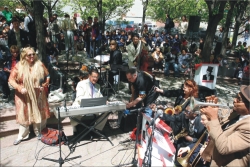Duke Ellington Center’s Free Concert Encourages Music & Arts In Public Schools
Encourages Music and Arts in Public Schools
Ellington “Messengers of Harmony” buttons, hundreds of school children
gathered around the Duke Ellington Statue this afternoon, at the
northeast corner of Central Park, for a free Duke Ellington Day Concert
hosted by The Duke Ellington Center for the Arts.

![]() Mahattan, NY, April 30, 2010 –(PR.com)– Children from schools in the
Mahattan, NY, April 30, 2010 –(PR.com)– Children from schools in the
immediate neighborhood watched and listened among a large audience of
New Yorkers and tourists of all ages, as their peers played music,
danced, recited poetry and even participated in a jam session with
professional musicians from the Blue Millennium Orchestra. The show
included a spectacular presentation by 30 tiny musicians from Brooklyn’s
Public School 345 Concert Band, after which the assembled throng
marched across Central Park, to the sound of Duke Ellington’s amazing
two-note composition “C-Jam Blues”—led by 40 Fifth Graders from the
nearby Allen Stevenson School piping away passionately on their
recorders.
April 29 was declared Duke Ellington Day in New York
City last year, and Duke Ellington’s granddaughter, Mercedes Ellington,
is determined to use the annual occasion as an opportunity to highlight
the importance of music and arts programs in schools. Based on her
ongoing collaboration with the Louis Armstrong Music Therapy Program at
Beth Israel Medical Center, Ms. Ellington believes that participation in
the arts makes children healthier.
On hand to present the
scientific facts was Dr. Joanne Loewy, Director of The Louis Armstrong
Center for Music and Medicine at Beth Israel Medical Center. In brief,
but well-founded remarks, Dr. Loewy spoke about the influence of music
in keeping children and teens healthy and invested in wellness. Apart
from the expected emotional and psychological benefits of playing music,
Loewy highlighted the nexus between jazz in particular and a range of
physical benefits that children with asthma derive from playing. “The
Center’s Asthma Initiative Program (AIP) gives kids free Yamaha winds
and teaches them jazz and improvisation, which keeps them breathing and
in control of their symptoms,” said Loewy.
Kicking off the
program, the Blue Millennium Orchestra played a small selection from
Duke Ellington’s vast repertoire of over 3,000 songs. Noted jazz/opera
vocalist Darby Dizard accompanied the band, frequently encouraging
participation from the children. Up next, was Harlem’s own Duke
Ellington School and their Ellington Poets Society with a couple of
delightful poems featuring the importance of music, and a combined
delivery in both English and Spanish.
Two brilliant teenage poets
from The Heritage School took the stage and presented their own
personal and very touching compositions describing Duke Ellington’s
influence on their own appreciation of music, art and culture.
One
of the highlights of the show was the Dance Times Square Dance School
Ensemble, with three couples delivering a fascinating performance of the
Lindy Hop. This was followed by the absolute stars of the show: The
P.S. 345 Concert Band. Made up of 30 grade school children from one of
the most downtrodden areas in Brooklyn, these young musicians, who
practice year-round from 7 to 8 every morning, stole the hearts of
everyone in the audience with their disciplined and excellent
performance of several Ellington numbers, including complex arrangements
of “Caravan” and “Satin Doll.”
The biggest surprise of the day
was the jam session between the professional musicians from the Blue
Millennium Orchestra and the kids from P.S. 345, featuring Ellington’s
“It Don’t Mean A Thing, If It Ain’t Got that Swing.” As the concert
gradually came to a close, 40 fifth graders of the Allen Stevenson
School’s Recorder Ensemble took over—preparing the audience for the
march to follow, playing “C-Jam Blues” (also called “Duke’s Place”).
Following these young pipers, the crowd marched across Central Park to
the West Side—umbrellas aloft, New Orleans style—with all of the
professional and student musicians joining in the music.
Given
the connection between music, the arts and children’s health—both
physically and emotionally, lead sponsors for this year’s event were
Emblem Health and Fidelis Care NY. Though competitors in delivering free
health coverage to children in New York, the two companies support the
Ellington Center’s view that important goals are best accomplished by
harmonious collaboration. Representatives of the companies handed out
gifts to the children and information about free health insurance to
parents. Mrs. Matilda Raffa Cuomo of Mentoring USA, lauded the
achievement as “an impressive milestone that signals a remarkable
turning-point in the business community.”
Edward Kennedy “Duke”
Ellington (April 29, 1899 to May 24, 1974) was a bandleader, pianist and
the twentieth century’s most prolific composer. He started playing the
piano when he was 7 years old, formed his first band when he was 25, and
kept it going for more than 50 years. He traveled with his band all
over the globe bringing American Music to audiences large and small on
every continent. When the U.S. State Department launched their “Jazz
Ambassador” program in 1956, Duke became a key component of that highly
successful global exercise in cultural diplomacy. He received the
Presidential Medal of Freedom in 1969. The Jazz Ambassador initiative
ended in 1972 after Duke, though battling terminal cancer, made the last
goodwill tour through Africa. He died two years later.
A source
of immense pride and a great example of equality for Americans, black
and white, Duke felt that racial integration was just a stepping stone
to a much more important universal goal: Human harmony beyond category.
As he traveled the world, Duke saw that his music often had the effect
of helping people overcome their differences. Based on Duke’s
philosophies, The Duke Ellington Center for the Arts now develops
programs to stimulate harmony among people using music and the arts. The
Center seeks to help individuals become “Messengers of Harmony” in the
world by encouraging more engagement in music and the arts—especially at
a young age.